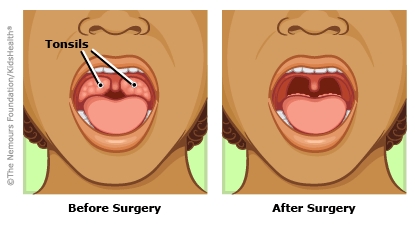Your child had a tonsillectomy (surgery to take out the tonsils). You can help them recover by giving the pain medicine as directed and making sure they get enough to drink. They should feel better within a week or so. Follow these instructions as you care for your child.


General Care
Pain Control
Preventing Dehydration

Your child:

Your child:

What are the tonsils? They're lumps of tissue on both sides of the back of the throat and are part of the body's germ-fighting immune system. The body has many ways to fight germs, so taking out the tonsils doesn't make your child more likely to get infections. But your child can still get sore throats, colds, and throat infections just like kids who have their tonsils.
Why are tonsils removed? In kids, it's usually done because they have:
What problems can happen after a tonsillectomy? Most kids recover from a tonsillectomy without any problems. Some kids get dehydrated if the pain after surgery makes them not want to drink. Less often, someone can have bleeding or an infection.